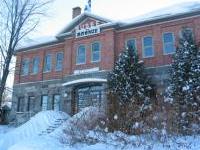 Located in the beautiful Appalachian Mountains, the village of Inverness is remarkable for its rolling landscapes and its roads that wind through valleys and around green hills offering a unique sight on the grounds, the pastures, the brooks and the forests. The Becancour River crosses the village from North to South, taking its source from Lake Joseph and flowing north towards Lysander Falls.
Located in the beautiful Appalachian Mountains, the village of Inverness is remarkable for its rolling landscapes and its roads that wind through valleys and around green hills offering a unique sight on the grounds, the pastures, the brooks and the forests. The Becancour River crosses the village from North to South, taking its source from Lake Joseph and flowing north towards Lysander Falls.
The first significant group of immigrants arrived from Scotland in the fall of 1829. They settled near Lake Joseph to spend the first winter (formerly known as Mooney’s Lake or Loch Lomond), where Abenaki Indians helped them to survive the cold. When spring came, they took possession of their 100 acres of land, granted to all men 21 years and older. Several subsequent groups of Scots and a few Irish, settled in Inverness until the mid-century, and accelerated the development undertaken by their predecessors. That is how started what was known as “Inverness Corner" in 1850, and later became Inverness Village.
Inverness possesses a very rich past, with two cultures living side by side, the Anglo Protestant and the Roman Catholic. The Protestants implanted their institutions, Churches, cemeteries and schools, and the French-speaking people thereafter established, in addition to their church and catholic congregation, some institutions like the annual beef auction and Beef Festival. They strengthened the agricultural and forestry vocation of Inverness, forging a reputation that largely exceeds its borders.
Witnesses of the past, several buildings remind to us the years of great social and economic activities at the village, whereas it was named chief town of the County of Megantic in 1855. The Courthouse, also acting as Registry Office and Town Hall was built in 1860. Four Protestant churches still exist, including two still in function, the third one was transformed into a Bronze Foundry and Art Gallery and the last one is now a Cultural Centre. Three Protestant manses are now private residences, and the catholic rectory shelters a residence for elderly people. The Inverness Academy, built in 1889, made a valuable contribution to the advancement of education in the area for seventy-five years. Today it is also a private residence.
At the beginning of the years 1970, Inverness became a destination for the urban people who wanted to return to a more simple way of life, in the trend of the “hippy” movement. The "Youks", from the French expression "D’you qu’y viennent" (where are they coming from), formed a homogeneous community, composed of artists, apprentice farmers and free lancers. Some stayed only a few years, and the more perseverant and imaginative ones remained and created in their turn other institutions such as the Bronze Museum, located in the former Town hall and Registry building and the Art Foundry of Inverness, installed in an old Methodist Church. Inverness became an artist’s village, where sculptors, painters, and others found the inspiration and the facilities to perform their art.